GCSE Tutoring Programme
Our chosen students improved 1.19 of a grade on average - 0.45 more than those who didn't have the tutoring.
This topic is relevant for:

Sequences
Here we will learn about different types of sequences including arithmetic sequences, geometric sequences and quadratic sequences and how to generate them and find missing terms, along with special sequences like the fibonacci sequence. We will also learn how to find the nth term of linear sequence and the nth term of a geometric sequence and how to work out whether a particular number appears in a sequence.
There are also sequences worksheets based on Edexcel, AQA and OCR exam questions, along with further guidance on where to go next if you’re still stuck.
What is a sequence?
A number sequence is a set of numbers that follow a particular pattern or rule to get from term to term.
There are four main types of different sequences you need to know, they are arithmetic sequences, geometric sequences, quadratic sequences and special sequences.
What is a sequence?
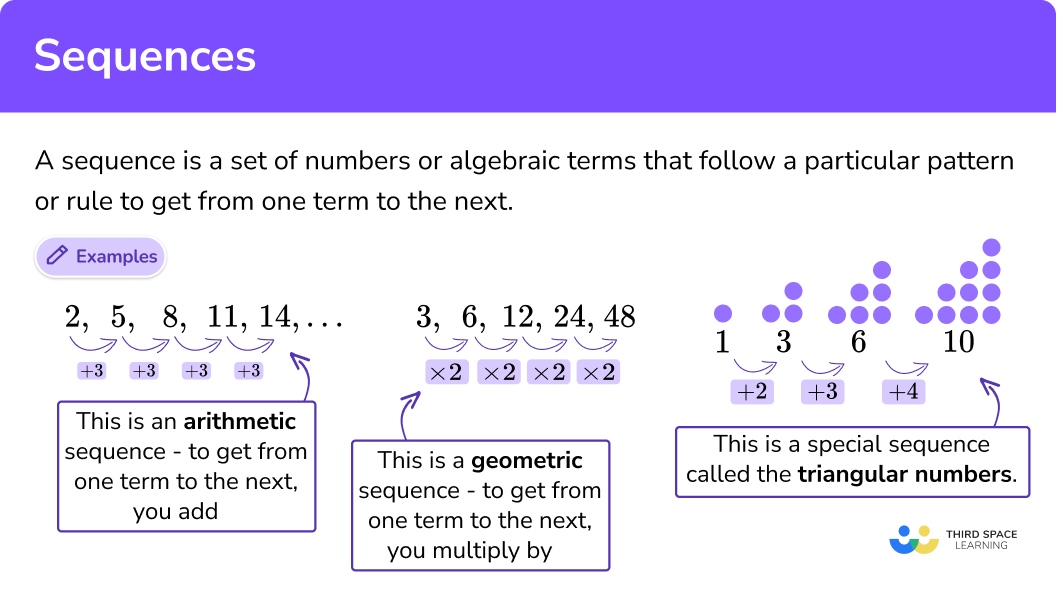
1Arithmetic sequences
An arithmetic sequence is an ordered set of numbers that have a common difference between each term.
If we add or subtract by the same number each time to make the sequence, it is an arithmetic sequence.
Step-by-step guide: Arithmetic Sequence
Arithmetic sequences examples
Example 1: sequence with a term to term rule of +3.
We add three to the first term to give the next term in the sequence, and then repeat this to generate the sequence.
Example 2: sequence with a term to term rule of -1.
We subtract 1 from the first term to give the next term in the sequence, and then repeat this to generate the sequence.
We can work out previous terms by doing the opposite of the term to term rule.
2Geometric sequences
A geometric sequence is an ordered set of numbers that progresses by multiplying or dividing each term by a common ratio.
If we multiply or divide by the same number each time to make the sequence, it is a geometric sequence.
Step-by-step guide: Geometric sequences
Geometric sequences examples
Example 3: sequence with a term to term rule of ×2.
We multiply the first term by
Example 4: sequence with a term to term rule of ÷2.
We divide the first term by
3Quadratic sequences
A quadratic sequence is an ordered set of numbers that follow a rule based on the sequence
The difference between each term is not equal, but the second difference is.
Step-by-step guide: Quadratic sequences
Quadratic sequences example
Example 5: sequence with common second difference of +2.
We find the first difference of the sequence and then find the term to term rule for the second difference. The second difference will always be the same for quadratic sequences.
4Special sequences
You will need to be able to recognise some important special sequences.
Special sequences examples
Example 6: square numbers
A square number is the result when a number is multiplied by itself.
E.g.
The square numbers can form a sequence:
Example 7: cube numbers
A cube number is the result when a number is multiplied by itself three times.
E.g.
The cube numbers can form a sequence:
Example 8: triangular numbers
The triangular numbers as numbers that can form a triangular dot pattern. They are also special type of quadratic sequence.
We can generate a sequence of triangular numbers by adding one more to the term to term rule each time:
Example 9: Fibonacci numbers
We can generate the Fibonacci Sequence of numbers by adding the previous two numbers together to work out the next term.
First and second terms:
We start with
Sequence:
Fourth Term:
Sequence:
Fifth Term:
Sequence:
We can continue to follow the pattern to generate an infinite sequence.
The Fibonacci Sequence:
The Fibonacci Sequence forms a spiral that is seen throughout nature.
What are the four main types of different sequences?
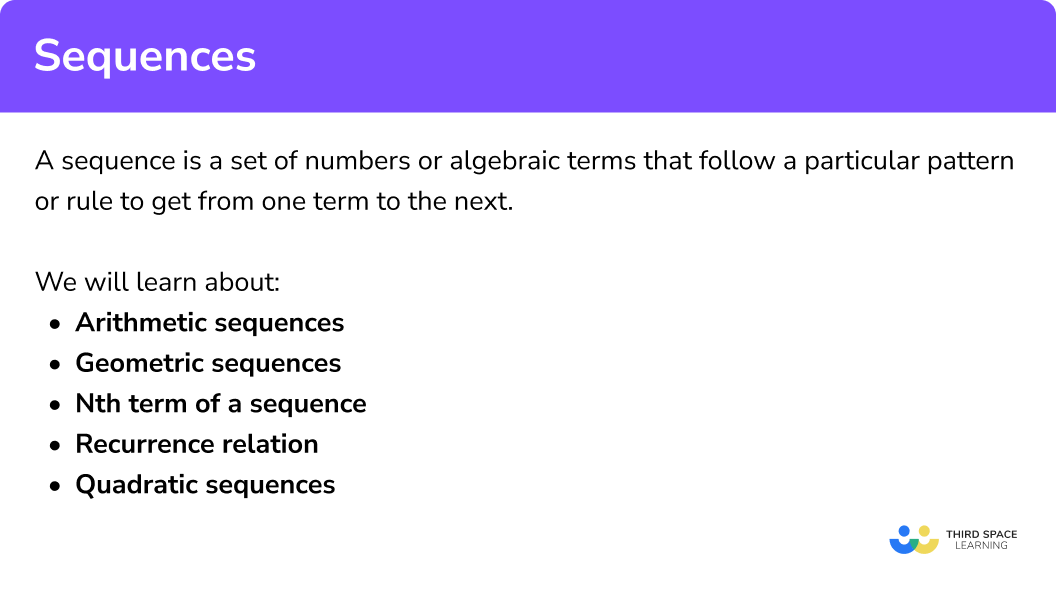
Sequence rule to find a term
We use the
By substituting in the number of the term we want to find as ‘
E.g.
What is the
4, 10, 16, 22, …
The
To find the 21st term,
(6 x 21) – 2 = 124
The 21st term is 124.
E.g.
Given the
To find the 20th term,
(3 x 20) + 4 = 64
To find the 100th term,
(3 x 100) + 4 = 304. The 20th term is 64 and the 100th term is 304.
How to find the nth term of a sequence
The
We will need to be able to find the
We can make a sequence using the nth term by substituting different values for the term number
Step-by-step guide: Nth term of a sequence
See also: Recurrence relation
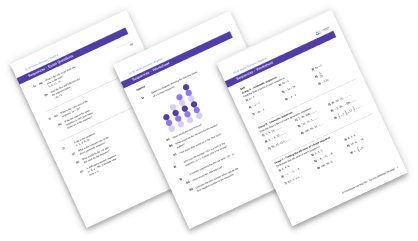
Sequences worksheet

Get your free sequences worksheet of 20+ questions and answers. Includes reasoning and applied questions.
DOWNLOAD FREE
Sequences worksheet

Get your free sequences worksheet of 20+ questions and answers. Includes reasoning and applied questions.
DOWNLOAD FREE1nth term of a linear sequence
In order to find the
- Step 1: find the common difference for the sequence.
- Step 2: multiply the values for
n =1, 2, 3 , … by the common difference. - Step 3: add or subtract a number to obtain the sequence given in the question.
How to find the nth term of a linear sequence
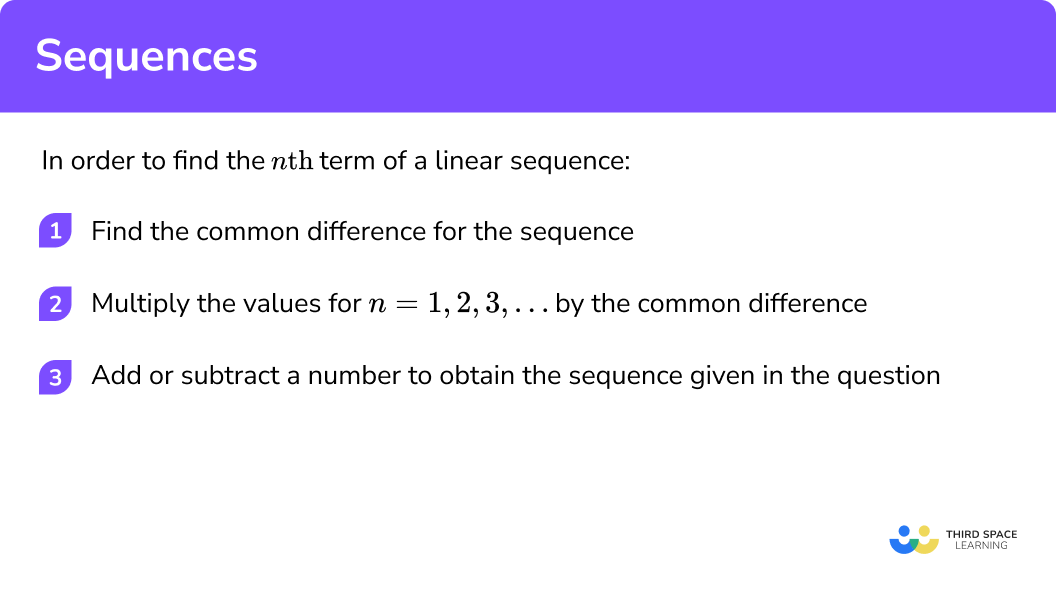
nth term of a linear sequence example
Find the
Find the common difference for the sequence.
The common difference
Multiply the values for n = 1, 2, 3, … by the common difference.
Here, we generate the sequence 4
Add or subtract a number to obtain the sequence given in the question.
The nth term of this sequence is
2nth term of a quadratic sequence
In order to find the
- Step 1: find the first difference
(d1) and second difference(d2) for the sequence.
- Step 2: Halve the second difference to find
a , the coefficient ofn2 .
- Step 3: Subtract
an2 from the original sequence.
- Step 4: If this produces a linear sequence, find the
n th term of it.
- Step 5: Add the
n th term for the linear sequence toan2 to work out then th term of the quadratic sequence.
How to find the nth term of a quadratic sequence
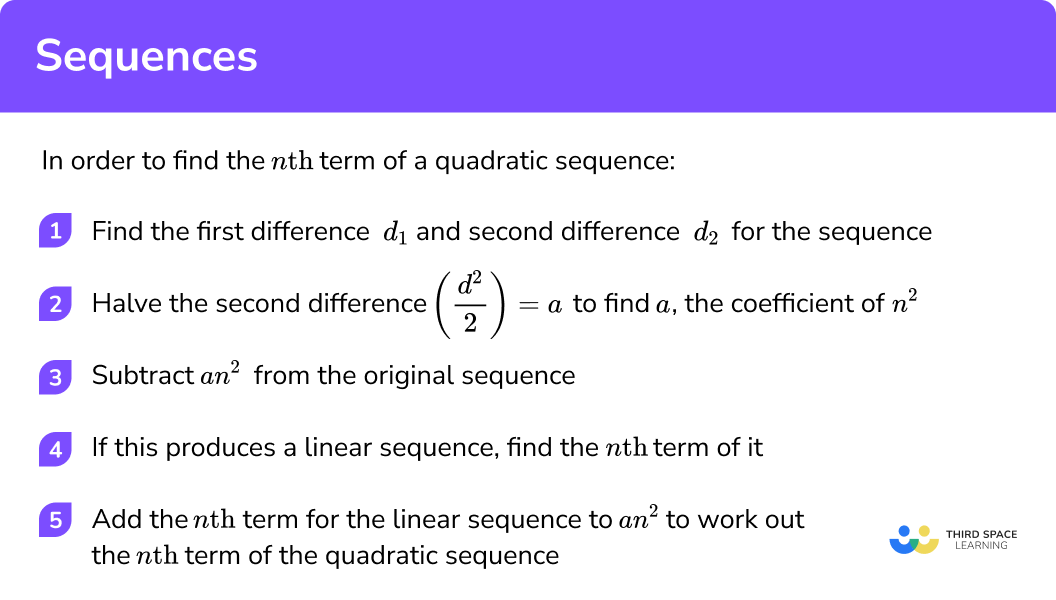
nth term of a quadratic sequence example
Find the
Find the first difference (d1) and second difference (d2) for the sequence.
The second difference
Halve the second difference to find a the coefficient of n2.
As
This means
Subtract 3n2 from the original sequence.

Here, the remainder for each term is
Find the nth term for the linear sequence generated.
Not required for this example as the remainder is
Add the nth term for the linear sequence to 3n2 to find the nth term of the quadratic sequence.
The nth term of the quadratic sequence is 3
Step-by-step guide: Quadratic nth term
3Use the nth term to calculate any term in a sequence
We can calculate any term in a sequence by substituting the term number into the
nth term to calculate any term in a sequence example
Example 10: find terms in the sequence with nth term = 4n+1
- For the first term,
n=1
So 1st term =
- For the
10th term,n=10
So
- For the
100th term,n=100
So
Example 11: find the first three terms in the sequence n2 + 7n
- For the first three terms we use n=1, n=2 and n=3:
4Use the nth term to work out whether a number is in a sequence
We can use the
Because
i.e. for the 1st term
When n is an integer then the number is in the sequence.
nth term to work out whether a number is in a sequence examples
Example 12: when n is an integer then the number is in the sequence
Is
Let’s put
As
So
Example 13: when n is not an integer then the number is not in the sequence
Is
Let’s put
As
5Solve problems using algebra in sequences
We can write any type of sequence described above using algebraic terms rather than numerical terms.
For example, the sequence,
3a , 3a+2 , 3a+4 , 3a+6is an arithmetic sequence, because we add 2 each time to get from one term to the next.
We can apply skills such as solving linear equations and solving simultaneous equations to sequences with algebraic terms.
Example 14: a Fibonacci sequence
The first three terms of a Fibonacci sequence are,
a , a+2 , 2a+2The 3rd term is 12.
Find the value of the 4th term.
First we form and solve an equation using the information given about the 3rd term:
2 a+2 =12 2 a =10 a =5We also need to find an algebraic expression for the 4th term. To get the next term in a Fibonacci sequence, we add the two previous terms. So the 4th term will be the sum of the 2nd and 3rd terms:
(a+2)+(2a+2)=3a+4To find the value of the 4th term, substitute a=5 to get 3(5)+4=19.
So the 4th term is 19.
Step-by-step guide: Sequences algebra
Common misconceptions
- Mixing up arithmetic and geometric and quadratic sequences
- Arithmetic sequences are generated by adding or subtracting the same amount each time – they have a common difference
d . - Geometric sequences are generated by multiplying or dividing by the same amount each time – they have a common ratio
r . - Quadratic sequences have a common second difference
d2 .
- Arithmetic sequences are generated by adding or subtracting the same amount each time – they have a common difference
- Mixing up working out a term in a sequence with whether a number appears in a sequence
In order to find any term in a sequence using the
E.g.
- For the
5th termn=5 ,
So
- For the
8th termn=8
So
In order to work out whether a number appears in a sequence using the
E.g.
Is
As
Practice sequences questions
1. Find the nth term of 1, 5, 9 ,13, …




The common difference here is 4 so it is 4n .

To get from 4n to our sequence we need to subtract 3 so our sequence is 4n-3 .
2. Find the nth term of 7, 4, 1,-2,-5, …




The common difference here is -3 so it is -3n .

To get from -3n to our sequence we need to add 10 so our sequence is -3n+10 .
3. Find the nth term of 6, 17, 32, 51, 74




Here the second difference is 4 .
4 \div 2 = 2
So it is 2n^{2}

We now need to work out the nth term formula for 4, 9, 14, 19, 24 ,..
The difference is 5 so it is 5n .

To get from 5n to our sequence we need to subtract 1 so it is 5n-1 .
The overall formula for the sequence is 2n^{2}+5n-1.
4. Generate the first 6 terms of the sequence 3n-4





5. Work out the 10 th term of the sequence 25-n^{2}




n=10
\begin{aligned}
25-10^{2}&=25-100\\
&=-75\end{aligned}
6. Write down the next three terms in this sequence: 0, 1, 1, 2, 3, 5, 8, …




This is the Fibonacci Sequence. We add the two previous terms to get the next term:
\begin{aligned} 5+8=13\\ 8+13=2\\ 13+21=34 \end{aligned}
Sequences GCSE questions
1. (a) 5, 8, 11, 14
What is the rule to get from one term to the next?
(b) What is the nth term of the sequence?
(2 marks)
+3
(1)
3n+2
(1)
2.(a)What is the 12 th term in the sequence 2n-20 ?
(b) Is 180 a number in the sequence?
(3 marks)
4
(1)
\begin{aligned} 2n-20&=180\\ 2n&=200\\ n&=100 \end{aligned}
(1)
Yes because n is an integer. 180 is the 100 th term in the sequence.
(1)
3. Look at this sequence 1, 2, 4, 8, 16
(a) What is the common ratio in the above geometric sequence?
(b) What would be the 7 th and 8 th term for the sequence?
(3 marks)
2
(1)
7 th term= 32 \times 2 = 64
(1)
8 th term= 64 \times 2 = 128
(1)
Learning checklist
You have now learned how to:
-
Recognise arithmetic sequences and find the nth term.
-
Recognise and use sequences of triangular, square and cube numbers, simple arithmetic progressions, Fibonacci Sequences, quadratic sequences, and simple geometric progressions.
-
Generate terms of a sequence from either a term-to-term or a position-to-term rule.
-
Recognise and use quadratic sequences.
-
Deduce expressions to calculate the nth term of quadratic sequences.
The next lessons are
Still stuck?
Prepare your KS4 students for maths GCSEs success with Third Space Learning. Weekly online one to one GCSE maths revision lessons delivered by expert maths tutors.

Find out more about our GCSE maths tuition programme.